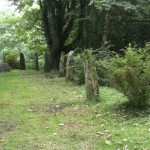The Menhirs
Ten menhirs or standing stones have been erected on one of the terraces. While walking the local beaches during the making of The Anchorage gardens (mainly by collecting and arranging the many scattered large blocks of sandstone-conglomerate derived from the thick layer beneath the garage) , the owner was surprised to find menhirs on the beaches. These had been used by farmers as gateposts (the hinges are still in them) and since World War II many had been replaced by concrete block posts. Some of the old stones were thrown over the cliffs and others abandoned in ditches near the modern gates. Most of them were purchased from the farmers and brought to The Anchorage as garden ornaments, where they have been placed around one of the terraces. If one reads books on ancient stone circles such as AVEBURY one learns of long avenues of these stones. At Avebury the stones (all of which are generally tear drop shaped) can be stood in the ground either with the narrow pointed edge upwards or the boad rounded end upwards. The pointed ones are referred to as male stones and the broader ones as female stones. At Avebury the male and females stones of the avenues were arranged alternatively. A large “alter stone” was also placed with the menhirs. It is the biggest block of rock found in the gardens of The Anchorage, and like all the other big stones, is derived from the thick sandstone-conglomerate bed crossing the valley beneath the garage. It took some years before a method was found to get it into position. It proved too big to lift by mechanical jaws and all ropes attached for lifting broke. Finally one very wet winter when the site was very muddy it was found to be a simple operation to push it uphill into position as it slid on the mud. It seems probable that these menhirs were originally used for Bronze Age burials but with the formation of large fields and machine ploughing most were removed for use as gateposts by farmers who later discarded them. A few still survive usually in non-ploughed areas as standing stones throughout Pembrokeshire.



